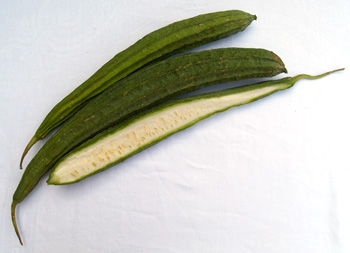
© Denzil Green
Luffa Gourds are closely related to cucumbers.
All varieties have thin skin, but one variety (Luffa acutangula) has ridges on it; the other (Luffa cylindrica aka Luffa aegyptica), has smooth skin.
The plant is an annual vine that grows from seed. The seeds have a tough shell on them, so take a while to germinate. The plant is tropical and does not like cold weather; it is frost intolerant.
The vines, which grow 10 to 15 feet (3 to 4 ½ metres) long, can be trained upwards. The leaves have a bad smell when crushed.
Vines of smooth-skinned varieties produce bright yellow flowers; vines of ridged ones produce white flowers, There are male and female flowers. Male flowers grow in clusters; female flowers are the ones that appear by themselves. The flowers rely on insects to do the pollinating.
The Luffa Gourds grow 1 to 2 feet (30 to 60 cm) long, and weigh up to 3 pounds (1 ⅓ kg.) Some varieties will be longer, some squatter. The skin ripens from green to yellow or yellowish-brown after a long growing season. The flesh inside is white.
When allowed to fully ripen, the flesh becomes quite fibrous, and then dries out and becomes light, and the rind will be hard. The dried out flesh frees up many small, flat, smooth black seeds, that will rattle inside.
For eating, Luffa Gourds should be harvested immature while they are still just 1 to 2 inches (2 ½ to 5 cm) wide, under 6 inches (15 cm) long and the skin is still green. Some cultivars are better for eating than others, as some have a bitter tasting skin. Good edible varieties include “Edible Ace” (popular in China and Taiwan), “Smooth Beauty”, “Hybrid Jupiter”, “Hybrid Green Glory”, and “Hybrid Asian Pride.”
The fibre of fully mature Luffa Gourds can be used as a sponge. To harvest for a sponge, you peel off the skin or soak in warm water for twenty minutes until the sponge will easily slip away from the rest of the gourd. Change the water a few times to help prevent the sponge inside from getting stained. Ridged ones are harder to peel to get the sponges out of.
When the fibre piece has been extracted, rinse to wash off any pulp, then remove and discard seeds.
The sponges are tan or light brown, but many like to bleach them in a weak (10%) standard bleach solution for an hour, or in a hydrogen peroxide solution. It isn’t necessary to bleach them, though the unbleached sponge can appear “stained” in some areas, but bleaching them does ensure that they are clean and sterile for use, free of any insects the eye can’t see, etc.
Luffa sponges that you buy commercially are grown from special commercial seed, and grown under very controlled conditions. Most home garden cultivars will produce smaller, fluffier, more flexible sponges that you might be fine with using, though they won’t compete with the commercial ones for quality.
Luffa sponges can be used to peel vegetables with. Allow the sponges to dry between uses; they will deteriorate quickly if kept damp all the time. The sponges can be washed in a washing machine or in the dishwasher.
Cooking Tips
Immature Luffa Gourds can be eaten raw, or cooked like summer squash.
Anything under 4 inches (10 cm) doesn’t need to be peeled. From 4 to 6 inches (10 to 15 cm), you may wish to peel it, as the skin can be bitter at that point,
The flowers on the ridged varieties can also be eaten as you would squash blossoms.
History Notes
Luffa Gourds are probably native to southern Asia. They were brought to Brazil by the Portuguese.
Sources
Davis, J.M. and C.D. DeCourley. 1993. Luffa sponge gourds: A potential crop for small farms. p. 560-561. In: J. Janick and J.E. Simon (eds.), New crops. Wiley, New York.

